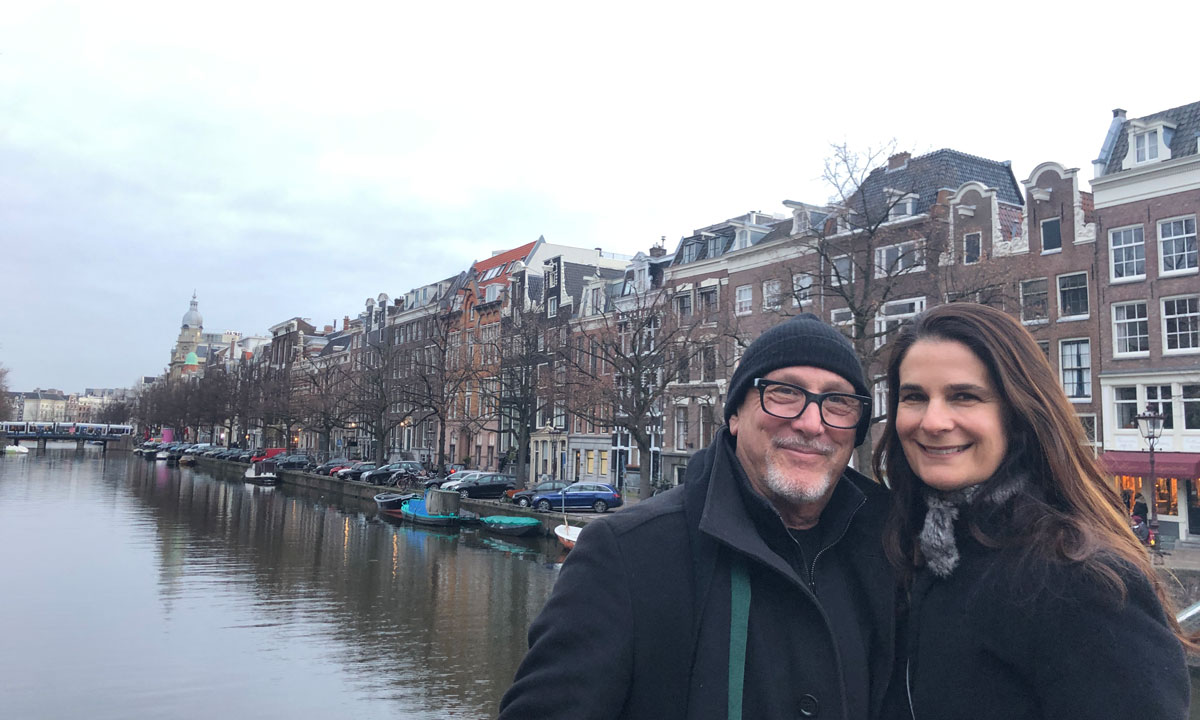
25 Feb Travel Deeper: The Monuments Men, A Roadmap for a European Vacation
“Conscience is a man’s compass” ~ Vincent van Gogh
Each year on the day after Christmas my husband Steve and I go on a kid-less vacation. Our alone time is rare and so coveted that we put a lot of thought into making the most of our retreat. Thankfully, my kids have super indulgent grandparents who watch my boys at their charming house in my hometown of Philadelphia.
After over a decade of this tradition, we have exhausted our favorite destinations in the Caribbean… all the sand and surf started to blend together. So, this year, we opted for a completely different environment. We chose classical music, culture, and winter weather over reggae, bikinis, and sunshine, and took a European excursion to Amsterdam (Holland), and Bruges, a medieval town in Belgium.
Each time I travel, I remind myself to pack light, but I never learn my lesson. I packed extra hats, scarfs and sweaters as my antidote to the uncertainty I felt about choosing a freezing cold destination. Why had I chosen Europe, and not in the spring?
With lots of quiet reading time ahead of me, I decided to pull the plug on the self-help books and self-anointed spiritual gurus I typically reach for. With my newly found confidence I said “fuck off” to never-ending metaphysical self-improvement and advice, and decided I’m fine just as I am.
Instead, I picked a non-fiction book from my shelf called The Monuments Men: Allied Heroes, Nazi Thieves, and the Greatest Treasure Hunt in History, a book I hadn’t opened since it was published in 2014. I love art history, but I didn’t realize my book choice would be the road map to my trip. On the plane I was completely engrossed, page after page, reading about Hitler’s exploits and the unimaginable art plundering from the exact places I would be visiting. I studied maps and key battles and began to understand World War II in a new context. Obviously, the toll this war took on lives is horrific and unimaginable, but the damage to cultural monuments and the wide scale theft of art and cultural treasures was something I never learned in school. The enormity of it was inconceivable prior to my journey, as I was about to find out.
Monuments Men were an unlikely but necessary force
In January 1944, American forces made a grave mistake by causing total destruction to a 1500-year-old Benedictine abbey called Monte Cassino, located 81 miles southeast of Rome, Italy. The Allied forces believed German soldiers were hiding in the formidable abbey and bombed the hell out of it, causing total destruction to one of Italy’s oldest religious sites. Subsequently, General Eisenhower called for the protection and respect of cultural monuments. And with that, the Army unit Monuments, Fine Arts, and Archives (MFAA) was formed. They became known as the “Monuments Men.”
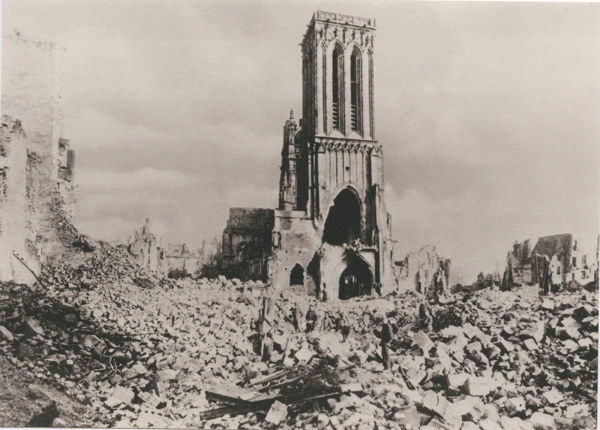
Destruction of the Church of St. Jean, Caen, France; a common example of destruction during World War II. Monuments Men visited destroyed sites to chronicle losses. (credit: Metropolitan Museum of Art).
The Monuments Men biography recounts the story of MFAA, made up of mostly American men and one remarkable French woman, Rose Valland, who rescued works of art looted by Nazis during the war. There were around 200 soldiers tasked in this very loosely-organized group, but the book’s focus is on the 12 central heroes on the front lines. The group was led by George Stout of Harvard’s Fogg Museum who recognized—long before we entered the war—the need for American art museums and curators to band together against the threat of war impacting humanity’s treasures. A meeting headed by Stout in 1941 sparked high profile art museums like The Metropolitan to close their less important galleries and replace staff with fireman in case of air raids. Masterpieces were secretly replaced with lesser works and transported to obscure locations. For example, The National Gallery in D.C. stashed 75 pieces of art at the Vanderbilt estate in North Carolina, where they remained hidden until 1944.
The Nazi banquet
Adolph Hitler and Nazi officers were as cruel and calculating against our cultural legacies as they were human beings, looting every art museum, gallery, historical building, and church of art, relics, sculpture, manuscripts, furniture and cultural assets as they swept across Europe and Russia. Hitler’s cherry-picked selections were to adorn the walls of his planned Führermuseum in his home town of Linz, Austria. Der Führer expected his museum to be the most spectacular in all the world, to rival the Louvre, and last as long as the Third Reich, an anticipated one thousand years.
In the art capital of Paris, SS officers not only stole from collectors of Jewish origin, but from the top 15 art dealers. One prominent Paris art dealer, Andre Seligmann, specialized in Old Master paintings. Seligmann’s entire collection was targeted and plundered on the orders of Hermann Göring, Hitler’s second in command. Göring’s appetite for art had no bounds, and he often competed with Hitler for the same revered pieces. Upon Nazi surrender, the Allies found Göring’s country estate packed with over 1,700 paintings and sculptures and as many as 20 rail cars on the way to deliver the rest of the stolen loot.
- A lone US soldier guards plunder stolen by Nazis that was hidden in a German church, 1945.
- The Ghent Altarpiece, also known as The Adoration of the Mystic Lamb, (click on photo to read more)
- Monuments Men rescue Leonardo da Vinci’s Lady With an Ermine . The painting was seized from the Czartoryski Collection in Poland in 1940.
The private collection of the Rothschild banking dynasty in Paris met a similar fate. Their mansion was commandeered by the Nazis and their extensive trove of antiques, art, silver, and jewelry was confiscated. Hitler’s most coveted painting by Dutch painter Johannes Vermeer, The Astronomer, was taken from the walls of the Rothschild mansion and held in a secret depository in the mountains of Austria.
In Paris alone, over 16,000 paintings were taken from the Jews. The plundered art was catalogued, packaged and shipped from the Jeu de Paume, an exhibition space for the Louvre, to depositories hidden all throughout Europe. An unlikely spy named Rose Valland, a volunteer at the Jeu de Paume, secretly tracked Nazi activities during their 4 years of French occupation. Her life-risking efforts led to the discovery of Hitler’s most coveted art cache hidden at Neuschwanstein Castle in the remote German alps.
Finding the aftermath
On my first morning in Amsterdam I woke to cloudy and dark skies. I looked out of my large fifth floor hotel window onto the streets and the notable buildings in Dam Square and I felt transported back to war time. A deep sadness came over me for the Jewish victims that were rounded up on these very streets. In the evening I visited Anne Frank’s home and ran my fingers lightly over the walls that secretly held her family together for 25 months. I saw a picture of Amsterdam Jews lined up to register with the Nazis to get their identifying badges, the Jewish star. How humbling it was to walk on the same cobblestone streets they once walked. At Amsterdam Central Train Station, I wondered if these were the same tracks that took Anne Frank to Auschwitz. While most people were getting stoned in Amsterdam (because it sure did smell like it), I was not. I felt connected to the pain of the war everywhere I went.
- Memorial brass plates, or Stolperstein- click photo to read more
- July 10, 1945: George Stout constructs a large pulley to lift Michelangelo’s Madonna of Bruges onto a salt cart at the salt mine in Altaussee, Austria.
- Neuschwanstein Castle was the key Nazi art repository for the greatest works of art stolen from France. It took Monuments Men 6 weeks to empty the castle, which contained over ten stories on elevated ground and no elevators.
We decided to go to Bruges for their legendary waffles and beer, but on the train ride I read about the Madonna of Bruges, the only Michelangelo sculpture to leave Italy. I knew I had to see this revered marble sculpture, plus I was staying within walking distance from the Church of Our Lady. The statue was purchased by a famous cloth manufacturer from Bruges in 1504 and donated to the Catholic church in the heart of this once important trade city. The statue has been stolen twice! The first time was during the French Revolution by Napoleon, and the second time by Hitler. Hitler had an art hit list that predated his invasions, and the Bruges Madonna was on the top of his list. In the early morning hours of September 8, 1944 German officers took the statue at gunpoint and sandwiched it between two mattresses. It was smuggled in a Red Cross truck to a salt mine in Altaussee, Austria which was used as an art repository. Monuments Men found the salt mine loaded with dynamite, and 700 feet below ground, with over 40 miles of tunnels, was the cache of priceless stolen art and artifacts. The Madonna was returned safely to Bruges where she resides to this day
Back in Amsterdam for my return flight, I went to my favorite coffee shop and was again reminded of the war. I passed by a plaque denoting the former studio of Max Beckmann, a German artist who fled to Amsterdam when the war broke out. Beckmann’s art was destroyed by Nazis because it was considered degenerate. Hitler despised modern, abstract, and expressionistic art, and thought it inferior and grotesque, abominations not fit to exist. He seized over 23,000 works of art he deemed degenerate such as Pablo Picasso, Paul Klee, Wassily Kandinsky, Marc Chagall, Otto Dix, Vincent van Gogh and Piet Mondrian. Some of the art was burned to make a statement but most of it was sold to support the Nazi regime.
“The story of Nazi looting after all, wasn’t merely the robbing of nations of their treasures and the human race of its historical and cultural touchstones. More than anything, the Nazis robbed families of their livelihoods, their opportunities, their heirlooms, their mementos, of the things that identified them and defined them as human beings.”–Robert M. Edsel, The Monuments Men
Picking up the pieces
In the end, the Monuments Men located over 1,000 Nazi art depositories in Germany alone. The total number of pieces of stolen art is officially unknown but more than likely is in the millions. All together it’s estimated that one fifth of all European art was looted. Thousands upon thousands of pieces were never returned to their rightful heirs, and thousands more are still missing. In 2018, a Dutch project to identify stolen and confiscated art from 63 art museums identified 170 works of art with questionable provenance. These pieces are being returned, but the Rijks Museum in Amsterdam has not yet completed the findings of their inventory. In 2012, an unknowing tax collector entered the Munich home of Cornelius Gurlitt, the son of a notorious Nazi art dealer. Inside the home of the recluse they found a treasure trove of stolen art, 1,200 pieces reportedly worth over a billion dollars by artists such as Picasso, Matisse and Delacroix.
In 2004 in Salt Lake City, Utah it was discovered that the Utah Museum of Fine Arts had a painting, The Young Lovers by Francois Boucher, in their permanent collection that was stolen by the Nazis. A researcher tracked the painting on the Art Loss Register and made the discovery. The painting was promptly returned to the living heirs of Andre Seligmann. After a 20 year legal battle with the Austrian government, the 1907 painting of Adele Bloch-Bauer, also called the Woman in Gold by Gustav Klimt, was finally returned along with 5 other Klimt paintings to Bloch-Bauer’s niece, Maria Altmann in 2006. The paintings were stolen from the family when they fled the war and became part of Adolph Hitler’s personal collection. Most recently in January 2019 a designer discovered a wall- to wall painting dating back to 1674 by Flemish painter Charles Le Brun in a Paris boutique he was constructing for Oscar de La Renta. The painting was hidden behind a wall experts believe was used to evade Nazi art thieves.
- Portrait of Adele Bloch-Bauer I by Gustav Klimt, commissioned by her husband. (Click on photo to read more).
- Found in Utah in 2004, The Young Lovers, Les Amoureux Jeunes by Francois Boucher
- Portrait of a Young Man by Raphael dating to 1514 is considered the most important painting still missing from the war. It was stolen from Cracow, Poland.
The dim awakening.
My trip to Europe was memorable not because of the waffles, coffee, architecture or the hotel at which I stayed, but for the new insight into the unseen consequences of war, including residual pain faced by successive generations. Although those who perished, and their families, paid the ultimate price, the loss of cultural artifacts to their vast number of unknown future benefactors is staggering. We’ll never know the true loss of any war, but especially not this one.
“But the lasting impact of his bitter reign is best measured in more ephemeral ways: fifty million loved ones who never returned home from the war to rejoin their families or start one of their own; brilliant, creative contributions never made to our world because scientists, artists, and inventors lost their lives too early or were never born; cultures built over generations reduced to ashes and rubble because one human being judged groups of other human beings less worthy than his own.” – Robert M. Edsel, The Monuments Men
Note:
In my opinion, please pass on seeing the movie The Monuments Men based on the book I describe here. Written and starring George Clooney, the movie is inaccurate and the screen play was not well-constructed. I felt the humor was clumsy and doesn’t fit into the context of the true story. One of the best films I’ve seen about Nazi art looting is called The Rape of Europa. I recommend this movie for its haunting footage and interviews from actual Monuments Men and Holocaust victims. It’s available on Amazon Prime.
Additional Reading:
Top 10 favorite pieces of art stolen by Nazis
Dutch Museum Discovers Hundreds of Artworks Stolen by the Nazis
Utah Art Found to be Nazi Loot
Son of Nazi Governor Returns Art Stolen from Poland during Second World War
Holocaust Restitution: Recovering Stolen Art
Museums Use ‘Nazi Tactics’ to Keep Art Stolen by the Nazis
3 Cases That Explain Why Restituting Nazi-Looted Art Is So Difficult


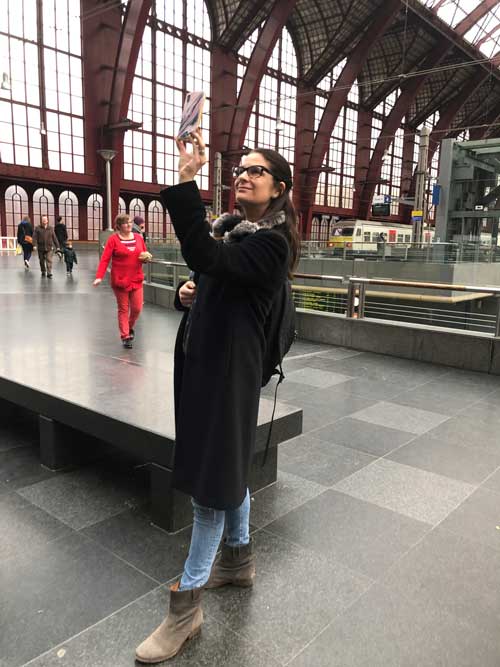
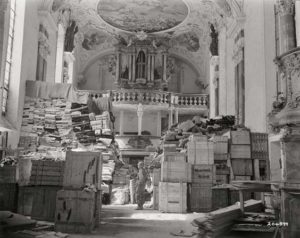
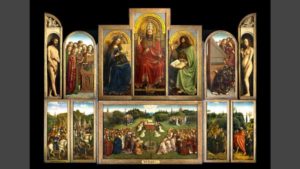
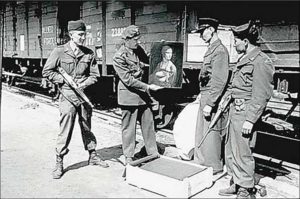
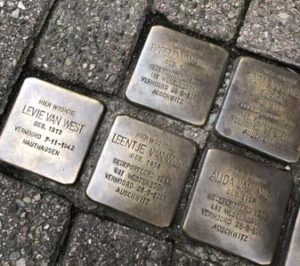


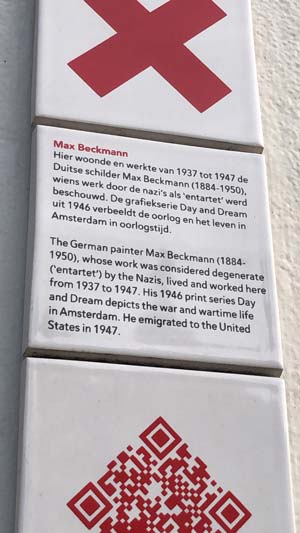



Emily Drown
Posted at 15:37h, 05 MarchI have stepped back in time and am walking those cobblestone streets, damp from the rain and filled will the sound of history. Christa, thank you for being my eyes. Your vivid descriptions, connected with the art I so dearly love, has me paused in the busyness of a weekday morning longing to revisit each masterpiece and see what other stories I have missed in my visual study. Thank you for gifting your personal pen to paper. So very touching dear friend!